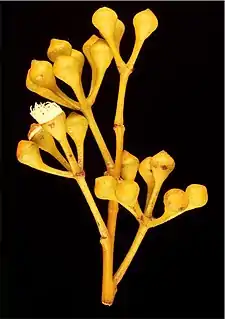Eucalyptus johnsoniana
Eucalyptus johnsoniana, commonly known as Johnson's mallee,[2] is a species of mallee that is endemic to Western Australia. It has smooth, greyish brown bark, sometimes with flaky to fibrous brownish bark at the base, lance-shaped adult leaves, flower buds in groups of seven, creamy white flowers and shortened spherical fruit with an unusually small opening.


| Johnson's mallee | |
|---|---|
 | |
| Scientific classification | |
| Kingdom: | Plantae |
| Clade: | Tracheophytes |
| Clade: | Angiosperms |
| Clade: | Eudicots |
| Clade: | Rosids |
| Order: | Myrtales |
| Family: | Myrtaceae |
| Genus: | Eucalyptus |
| Species: | E. johnsoniana |
| Binomial name | |
| Eucalyptus johnsoniana | |
Description
Eucalyptus johnsoniana is a mallee that typically grows to a height of 1–3.5 m (3 ft 3 in–11 ft 6 in) and forms a lignotuber. It has smooth greyish brown bark, sometimes with rough, flaky to fibrous bark on the lower part of the trunk. Young plants and coppice regrowth have dull bluish green, egg-shaped to elliptic leaves that are 30–110 mm (1.2–4.3 in) long and 10–30 mm (0.39–1.18 in) wide. Adult leaves are lance-shaped, 55–105 mm (2.2–4.1 in) long and 8–20 mm (0.31–0.79 in) wide on a petiole 5–15 mm (0.20–0.59 in) long. The flower buds are arranged in leaf axils in groups of seven on a peduncle 5–15 mm (0.20–0.59 in) long, the individual buds on pedicels 2–5 mm (0.079–0.197 in) long. Mature buds are oval to pear-shaped, 5–6 mm (0.20–0.24 in) long and 3–4 mm (0.12–0.16 in) wide with a rounded operculum. Flowering occurs from July to August or from October to January and the flowers are creamy white. The fruit is a woody, shortened spherical capsule with an unusually small opening.[2][3][4][5][6]
Taxonomy and naming
Eucalyptus johnsoniana was first formally described in 1978 by Ian Brooker and Donald Blaxell from a specimen Blaxell collected near the Brand Highway in 1975. The specific epithet honours "Dr. Lawrie Johnson, Director of the Royal Botanic Garden, Sydney".[3][7]
Distribution and habitat
Johnson's mallee grow in heath, mostly on undulating sandplain between Eneabba and Badgingarra.[2][5][6]
Conservation status
This mallee is listed as "vulnerable" under the Australian Government Environment Protection and Biodiversity Conservation Act 1999 and as "Threatened Flora (Declared Rare Flora — Extant)" by the Department of Environment and Conservation (Western Australia).[4] The current population size is estimated to be 360 plants. The main threats to the species are fire, land clearing and transmission line maintenance.[6]
See also
References
- "Eucalyptus johnsoniana". Australian Plant Census. Retrieved 2 August 2019.
- "Eucalyptus johnsoniana". Euclid: Centre for Australian National Biodiversity Research. Retrieved 1 June 2020.
- Brooker, M. Ian H.; Blaxell, Donald F. (1978). "Five new species of Eucalyptus from Western Australia". Nuytsia. 2 (4): 222–224. Retrieved 2 August 2019.
- "Eucalyptus johnsoniana". FloraBase. Western Australian Government Department of Parks and Wildlife.
- Chippendale, George M. "Eucalyptus johnsoniana". Flora of Australia. Australian Biological Resources Study, Department of the Environment and Energy, Canberra. Retrieved 2 August 2019.
- "Approved Conservation Advice for Eucalyptus johnsoniana (Johnson's Mallee)" (PDF). Australian Government Department of the Environment. Retrieved 2 August 2019.
- "Eucalyptus johnsoniana". APNI. Retrieved 2 August 2019.
